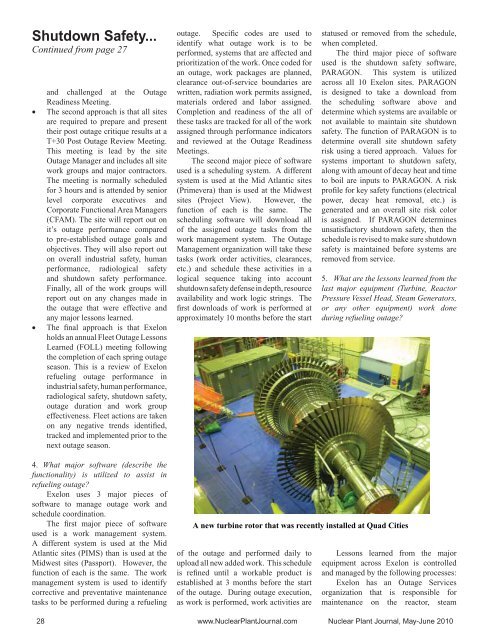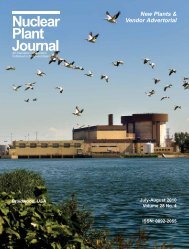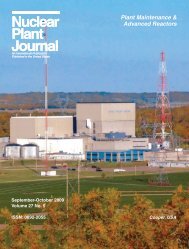New Energy - Digital Versions - Nuclear Plant Journal
New Energy - Digital Versions - Nuclear Plant Journal
New Energy - Digital Versions - Nuclear Plant Journal
Create successful ePaper yourself
Turn your PDF publications into a flip-book with our unique Google optimized e-Paper software.
Shutdown Safety...<br />
Continued from page 27<br />
and challenged at the Outage<br />
Readiness Meeting.<br />
• The second approach is that all sites<br />
are required to prepare and present<br />
their post outage critique results at a<br />
T+30 Post Outage Review Meeting.<br />
This meeting is lead by the site<br />
Outage Manager and includes all site<br />
work groups and major contractors.<br />
The meeting is normally scheduled<br />
for 3 hours and is attended by senior<br />
level corporate executives and<br />
Corporate Functional Area Managers<br />
(CFAM). The site will report out on<br />
it’s outage performance compared<br />
to pre-established outage goals and<br />
objectives. They will also report out<br />
on overall industrial safety, human<br />
performance, radiological safety<br />
and shutdown safety performance.<br />
Finally, all of the work groups will<br />
report out on any changes made in<br />
the outage that were effective and<br />
any major lessons learned.<br />
• The final approach is that Exelon<br />
holds an annual Fleet Outage Lessons<br />
Learned (FOLL) meeting following<br />
the completion of each spring outage<br />
season. This is a review of Exelon<br />
refueling outage performance in<br />
industrial safety, human performance,<br />
radiological safety, shutdown safety,<br />
outage duration and work group<br />
effectiveness. Fleet actions are taken<br />
on any negative trends identified,<br />
tracked and implemented prior to the<br />
next outage season.<br />
outage. Specific codes are used to<br />
identify what outage work is to be<br />
performed, systems that are affected and<br />
prioritization of the work. Once coded for<br />
an outage, work packages are planned,<br />
clearance out-of-service boundaries are<br />
written, radiation work permits assigned,<br />
materials ordered and labor assigned.<br />
Completion and readiness of the all of<br />
these tasks are tracked for all of the work<br />
assigned through performance indicators<br />
and reviewed at the Outage Readiness<br />
Meetings.<br />
The second major piece of software<br />
used is a scheduling system. A different<br />
system is used at the Mid Atlantic sites<br />
(Primevera) than is used at the Midwest<br />
sites (Project View). However, the<br />
function of each is the same. The<br />
scheduling software will download all<br />
of the assigned outage tasks from the<br />
work management system. The Outage<br />
Management organization will take these<br />
tasks (work order activities, clearances,<br />
etc.) and schedule these activities in a<br />
logical sequence taking into account<br />
shutdown safety defense in depth, resource<br />
availability and work logic strings. The<br />
first downloads of work is performed at<br />
approximately 10 months before the start<br />
statused or removed from the schedule,<br />
when completed.<br />
The third major piece of software<br />
used is the shutdown safety software,<br />
PARAGON. This system is utilized<br />
across all 10 Exelon sites. PARAGON<br />
is designed to take a download from<br />
the scheduling software above and<br />
determine which systems are available or<br />
not available to maintain site shutdown<br />
safety. The function of PARAGON is to<br />
determine overall site shutdown safety<br />
risk using a tiered approach. Values for<br />
systems important to shutdown safety,<br />
along with amount of decay heat and time<br />
to boil are inputs to PARAGON. A risk<br />
profile for key safety functions (electrical<br />
power, decay heat removal, etc.) is<br />
generated and an overall site risk color<br />
is assigned. If PARAGON determines<br />
unsatisfactory shutdown safety, then the<br />
schedule is revised to make sure shutdown<br />
safety is maintained before systems are<br />
removed from service.<br />
5. What are the lessons learned from the<br />
last major equipment (Turbine, Reactor<br />
Pressure Vessel Head, Steam Generators,<br />
or any other equipment) work done<br />
during refueling outage?<br />
4. What major software (describe the<br />
functionality) is utilized to assist in<br />
refueling outage?<br />
Exelon uses 3 major pieces of<br />
software to manage outage work and<br />
schedule coordination.<br />
The first major piece of software<br />
used is a work management system.<br />
A different system is used at the Mid<br />
Atlantic sites (PIMS) than is used at the<br />
Midwest sites (Passport). However, the<br />
function of each is the same. The work<br />
management system is used to identify<br />
corrective and preventative maintenance<br />
tasks to be performed during a refueling<br />
A new turbine rotor that was recently installed at Quad Cities<br />
of the outage and performed daily to<br />
upload all new added work. This schedule<br />
is refined until a workable product is<br />
established at 3 months before the start<br />
of the outage. During outage execution,<br />
as work is performed, work activities are<br />
Lessons learned from the major<br />
equipment across Exelon is controlled<br />
and managed by the following processes:<br />
Exelon has an Outage Services<br />
organization that is responsible for<br />
maintenance on the reactor, steam<br />
28 www.<strong>Nuclear</strong><strong>Plant</strong><strong>Journal</strong>.com <strong>Nuclear</strong> <strong>Plant</strong> <strong>Journal</strong>, May-June 2010












